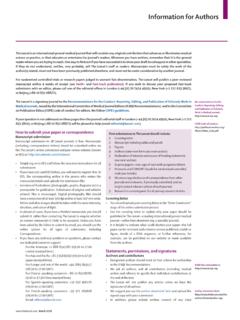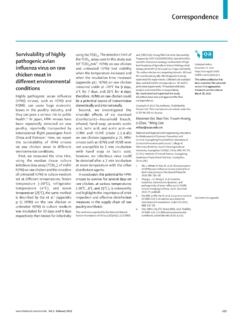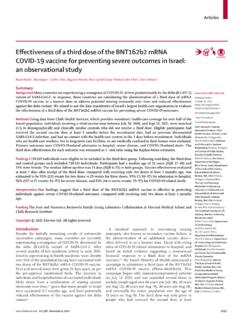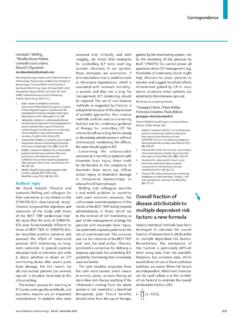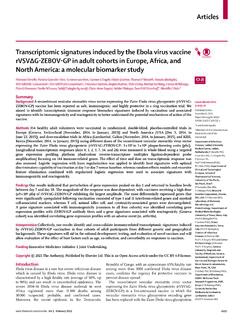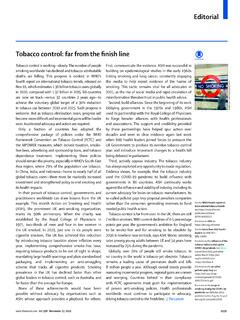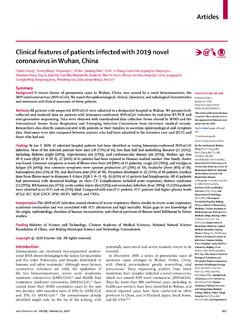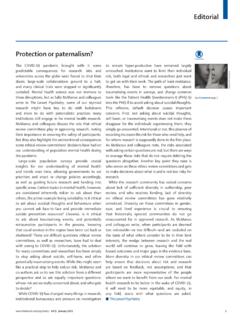Transcription of Reclaiming traditional, plant-based, climate-resilient ...
1 Vol 6 February 2022 e171 ReviewLancet Planet Health 2022; 6: e171 79 Department of Nutrition, Harvard TH Chan School of Public Health, Boston, MA, USA (A Marrero BSPH, J Mattei PhD)Correspondence to: Dr Josiemer Mattei, Department of Nutrition, Harvard TH Chan School of Public Health, Boston, MA 02115, USA traditional, plant-based, climate-resilient food systems in small islandsAbrania Marrero, Josiemer MatteiSmall island developing states face challenges in cultivating healthy food systems and are currently bearing substantial burdens of obesity and type 2 diabetes. Local food production rooted in collective local and Indigenous traditions, self-sufficiency, and climate-adaptive agricultural practices has long emphasised a fibre-rich, plant-based diet; however, common histories of dietary colonialism have replaced local, small-scale farming and fisheries with non-nutritive cash crops, intensive livestock operations, and high-quality food exportation.
2 Along with declines in traditional food availability, the resulting food import dependence has fostered a diabetogenic ecosystem composed of energy-dense cereal products, animal-based fats, and processed foods. The destabilisation of local food sectors undermines small island social and cultural systems, contributes to impoverishment and food insecurity during natural disasters, and, ultimately, can reduce diet quality and increase type 2 diabetes risk. Despite ongoing marginalisation of traditional local food systems, locally produced foods such as starchy roots, legumes, fruits, and seafood persist as nutritious and ecologically relevant cornerstones of self-determined local economic productivity and dietary health. Findings from community and epidemiological work suggest that local food production bolstered by local and Indigenous agroecological knowledge, cultural preservation, and collective agency can aid in Reclaiming healthy and climate-resilient small island food island developing states (SIDS) delineated by the UN as low-income and middle-income countries and other non-independent island territories throughout the Caribbean, the Pacific, the Atlantic, Indian Ocean, Mediterranean, and South China Sea1 bear substantial burdens of obesity and type 2 diabetes.
3 Although self-sufficient food production in local and Indigenous communities once utilised climate-adaptive practices to support a minimally processed and plant-based diet, common histories of globalisation have diminished and co-opted traditional local food sectors, amplifying food import dependence and diet-related chronic disease. Initially characterised as dietary colonialism in the Pacific, the destabilisation of local food production can extend to small islands around the world, amplifying poor socioeconomic conditions, contributing to periodic food insecurity during natural disasters, and under-valuing healthy and culturally relevant diets. In this Review, we aim to describe the interconnection between shifting food systems and type 2 diabetes risk in small islands (as systemically shaped by dietary colonialism) and we posit that local food production, informed by climate-resilient agroecological knowledge, cultural traditions, and collective self-determination, has the capacity to support a more nutritious and sustainable food 2 diabetes prevalence and contributorsSmall islands around the world have a disproportionate prevalence of diet-related chronic diseases.
4 In 2019, eight of the ten countries with the highest age-adjusted prevalence for diabetes were SIDS, and, in some SIDS, as many as one in three adults were diagnosed with diabetes (figure 1).2 Health disparities in insulin dysregulation have inten sified in SIDS and other low-income and middle-income countries due to an epidemiological transition associated with obesity, physical inactivity, and poor diet At the start of the century, the average mortality rate from diabetes in the Caribbean was five times that observed in mainland In Oceania, fasting plasma glucose rose by 0 22 mmol/L in men and 0 32 mmol/L in women per decade from 1980 to 2008, which is 3 5 times the average worldwide increase during the same Stark health disparities exist in SIDS, with Indigenous groups, such as Aboriginal and Torres Strait Islander people in the Pacific.
5 Having as much as a 20 year reduction in life expectancy compared with the total Australian population;6 however, both Indigenous and non-Indigenous island communities, including Black and South Asian populations in the Caribbean, have high levels of chronic disease morbidity and mortality, beckoning investigation of ubiquitous, structural facets of food and social rapid rise in type 2 diabetes among indigenous populations in small islands has long motivated biogenetic theories of disease, including the so-called thrifty gene hypothesis,8 despite sparse anthropological evidence for famine in regions with year-round subsistent food Other mechanisms have emphasised the metabolic mismatch of early-life undernutrition and subsequent obesity in these rapidly modernised.
6 Dual-burden food Despite these findings, a prevailing emphasis on biological determinism in the literature often fails to recognise the extensive role that past and ongoing marginalisation might have in increasing type 2 diabetes Diabetogenic environ-ments in SIDS have been proposed to stem from common histories of colonisation, through which healthy and climate-adaptive local food traditions were eliminated in the interests of the colonising The coerced shift away from traditional local food sources towards import e172 Vol 6 February 2022 Reviewdependence might offer insights into contemporary type 2 diabetes risk in island food an important driver of diet quality and chronic disease risk, the term dietary colonialism captures the processes by which colonial and neocolonial powers have exerted undue influence in small islands that, in turn, have destabilised local food and agricultural production, marginalised traditional food cultures, and created external food The inequitable integration of island political economies into the global market place by colonising nations and, increasingly, by trans national corporations and regional trade policies drives shifts in the food system of SIDS that diminish human health and agroecological climate resilience.
7 Originating in the historical displacement of biodiverse subsistence farming and fishing communities for non-nutritive plantations and forced labour, dietary colonialism continues to shape island food supplies via inexpensive meat and processed food importation,14 the erosion of cooperative social values and small-scale networks of food exchange,15 and the continued industrialisation and international mono polisation of local agricultural production. Instead of reinforcing genetic determinism and weight stigmati sation, efforts to promote nutritional health should recognise and grapple with long-standing structural barriers to cultural, economic, political, and communal food local food productionEvidence from early cultures documents a diverse range of nutrient-dense fruits and vegetables available in island ecosystems, many of which continue to shape current dietary preferences (table).
8 17 30 Indigenous communities subsisted on a fibre-rich and carbohydrate-rich diet, gathering seasonal fruits, legumes, nuts, and seeds and cultivating endemic root species, plantains, and other farinaceous crops in home-based ,23,31 Among Indigenous Caribbean tribes, archaeological evidence suggests a strong reliance on starchy plants such as cassava, yaut a, and maize, eventually intensifying towards root crop horticulture and ,19 Oceania, Polynesia, Micronesia, and Melanesia people subsisted MauritiusBahrainComorosSeychellesMaldive sBermudaSingaporeCabo VerdeGuinea-BissauS o Tom and Pr ncipeMarshall IslandsKiribatiTuvaluNew CaledoniaFrench PolynesiaSolomon IslandsGuamPapua New GuineaPalauTongaFijiNauruFederated States of MicronesiaVanuatuSamoaTimor-LesteBelizeV irgin IslandsPuerto RicoBarbadosSaint Kitts and NevisAntigua and BarbudaSurinameUS Virgin IslandsArubaCura aoDominicaGuyanaSaint LuciaJamaicaGrenadaThe BahamasCayman IslandsSaint Vincent and the GrenadinesTrinidad and TobagoCubaDominican RepublicSaint MaartenHaiti05101520253035100 Age-adjusted diabetes prevalence in adults (%)CountriesAtlantic, Indian Ocean, Mediterranean, and South China SeaPacificCaribbeanFigure 1.
9 Age-adjusted diabetes prevalence in adults (20 79 years) in small island developing states in 2019 The dashed line indicates the worldwide age-adjusted diabetes prevalence in adults. Data from the International Diabetes Vol 6 February 2022 e173 Reviewon taro, yams, breadfruit, banana,21,22 and other local fruits rich in carotenoids and rarely associated with population micronutrient On the west African coast, ancient grains such as millet and sorghum shaped the agricultural economies of early ,29 Apart from some seafood in coastal areas, animal protein only occasionally supplemented this plant-based diet, likely due to weather and natural resource-related constraints on land-based animal ,21,22,32 Linguistic evidence from the Hawaiian Islands suggests that small animal consumption was an ancillary luxury to more regularly consumed starchy Robust social networks also enabled the exchange of foods and agroecological knowledge, fostering a collective sense of community ,22,29 Historically, traditional local food production practices might have been climate resilient and designed to withstand highly variant ecological and climatic conditions.
10 Networks of numerous small farmers offered localised food sources, particularly among inland or remote ,29 A dietary reliance on starchy roots also reflected the need for an energy-dense food with a short growing season and underground protection from natural ,33 Archaeological evidence suggests that agricultural practices, such as terracing, agroforestry, and multicropping, preserved biodiversity, minimised erosion, and improved soil nutrient status, protecting the quality of sparse arable ,19,26 Traditional food trees in agroforestry and home gardens additionally enhanced food access and dietary diversity, particularly among rural and resource-constrained Culinary traditions also reduced the severity of food shortages during cyclones, droughts, and forest fires.
